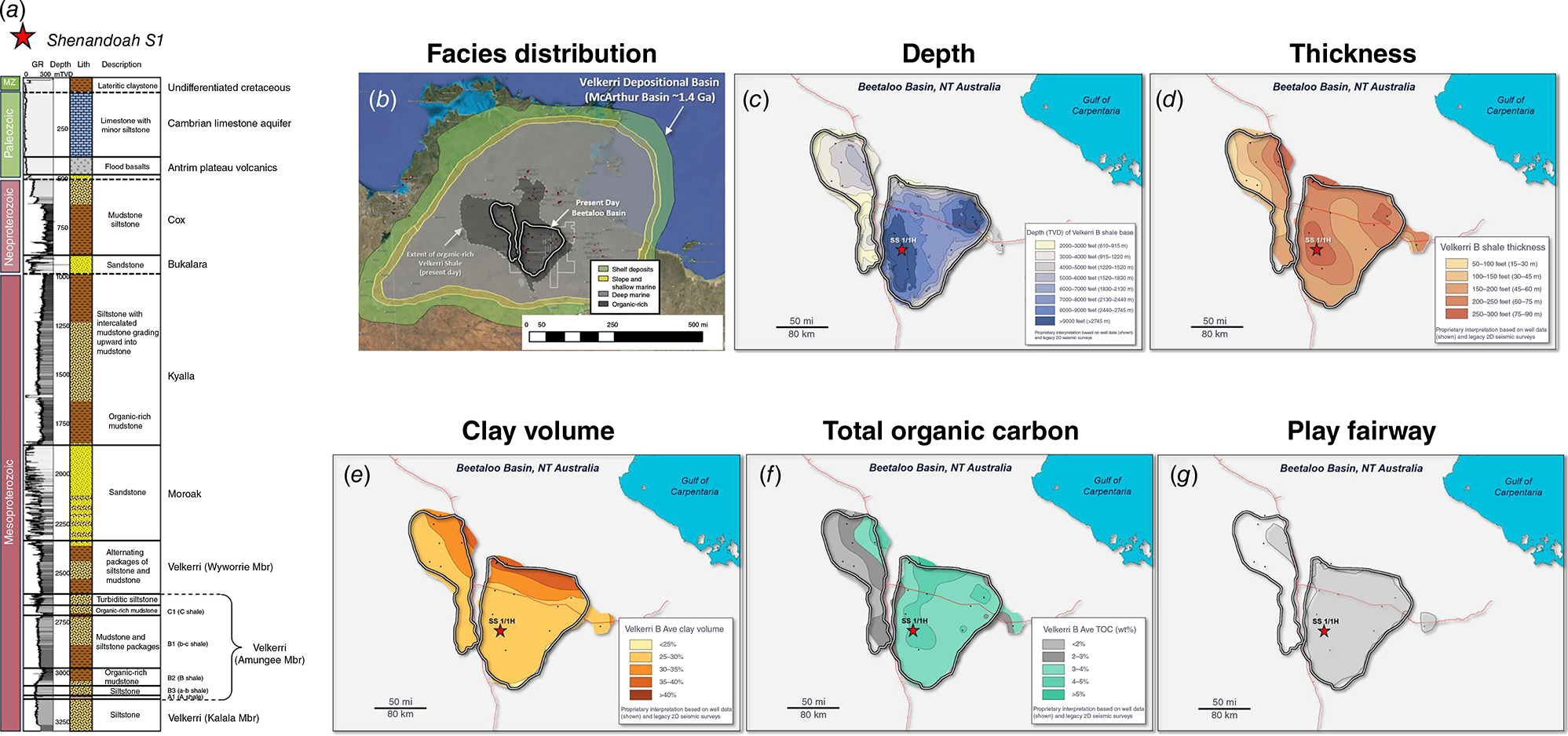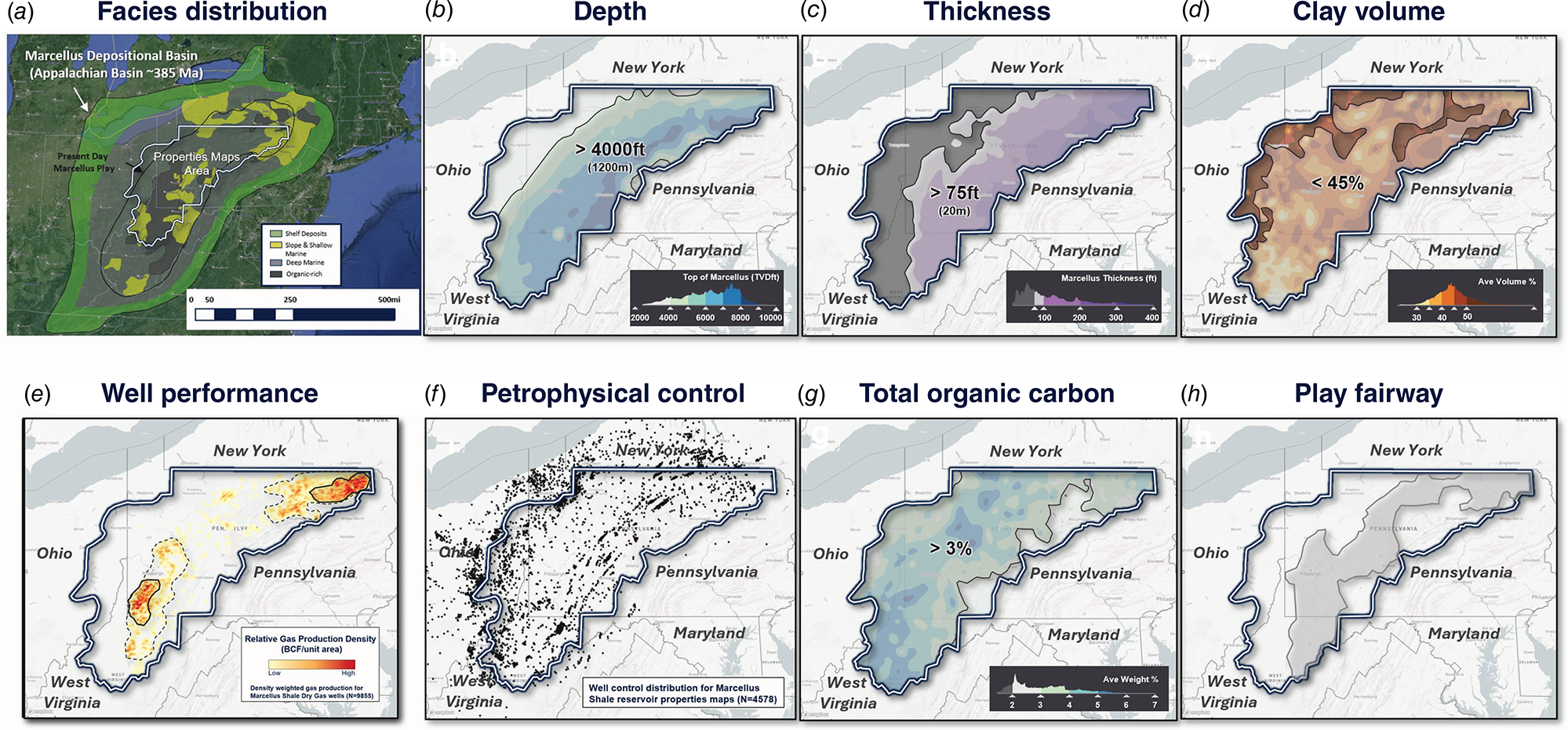A hierarchical application of 20+ years of learnings from North American unconventional exploration and appraisal activities to delineate a 1MM-acre ‘sweet spot’ in the Beetaloo Basin shale gas play, Northern Territory, Australia
Donny Loughry A *A

Donny Loughry is a Senior Manager of Geoscience and Technical Advisor at Tamboran Resources. He received a Master of Arts in Secondary Science Education from Georgetown College in 2006 and a Master of Science in Geology from the University of Kentucky in 2010. He has 15 years of experience in unconventional shale plays in the US and Australia, much of which he gained while working at Pioneer Natural Resources where he focused on geologic, petrophysical, and geomechanical characterisation and analysis for exploration, appraisal, drilling optimisation, and development of Pioneer’s unconventional assets and interests (Barnett shale, Spraberry, Wolfcamp, Eagle Ford, Appalachian Basin). He joined Tamboran Resources in 2021, where he is focused on exploring for hydrocarbons in the gas-rich Beetaloo Sub-basin in Australia’s Northern Territory. |
Abstract
The definition of a ‘sweet spot’ in unconventional shale plays varies from person to person, operator to operator, and analyst to analyst. More importantly, it varies with respect to the maturity of the play itself. Early in the life of a play, a sweet spot usually refers to an area where the properties of the target formation result in the highest performing wells, but a mature play may have a sweet spot associated with the lowest well costs, proximity to important infrastructure, or the highest return on investment. For a frontier basin in a remote setting like the Beetaloo, having only 15 vertical exploration wells and eight horizontals drilled to date, the definition is necessarily the former, and could be more appropriately termed the ‘first spot.’ High-rate well tests attract important investment dollars that allow appraisal to continue towards pilot development and first sales. Without these tests, the play concept quickly loses momentum. Exploration by Tamboran Resources and others in the Beetaloo Sub-basin suggests the presence of a world-class shale gas play. The key self-sourcing reservoir is the Mesoproterozoic aged Velkerri Formation (~1.4 Ga), which may be the oldest productive petroleum system in the world. Delineating the play boundaries of an unconventional shale is a relatively easy task, as the area is defined by meeting certain rock property thresholds (e.g. total organic content, depth, thickness, thermal maturity). Defining the sweet spot is much more involved, requiring an understanding of how to appropriately weight rock and reservoir properties at the basin scale of observation.
Keywords: Beetaloo, geologic mapping, performance drivers, play delineation, rock properties, shale gas, unconventional, Velkerri Formation.
Introduction
The Beetaloo Sub-basin (Fig. 1) contains a thick sequence of mudstone and sandstone formations (Roper Group) that were deposited during the Mesoproterozoic era, approximately 1400 million years ago. The Roper Group is estimated to reach more than 5000 m in thickness in the centre of the Sub-basin and is estimated to be thinner outside the formally defined Beetaloo Sub-basin boundaries. In the Beetaloo Sub-basin, the Roper Group is typically overlain unconformably by Neoproterozoic sediments. Unconformably overlying the Neoproterozoic section is the Georgina Basin (Cambrian) sedimentary package, which includes widespread extrusive flood basalts and a thick limestone sequence that forms the Cambrian Limestone Aquifer (CLA), a significant regional water supply aquifer. The Georgina Basin is capped unconformably by a thin section of Cretaceous mudstone and sandstone (Albian aged ~100–113 Ma) and recent alluvial and laterite deposits (Fig. 1a). The shale and sandstone layers of the Beetaloo Sub-basin’s Roper Group host the gas plays that are the target for petroleum exploration activities in the area (DEPWS 2022).
Beetaloo Sub-basin stratigraphy (a) and position within the greater McArthur Basin depositional setting, with inferred lithofacies distributions (b); lithofacies distributions inferred from Crombez et al. (2023). Mapped attributes of the Velkerri B shale (c–f) with play fairway (g).

Tamboran’s exploration and appraisal activities are targeting organically enriched shale intervals within the Roper Group’s Amungee Member of the Velkerri Formation (Fig. 1a). The Amungee Member is overlain with a thick series of low permeability units (mudstone, siltstones, tight sandstone and volcanic units). These stacked successions provide more than 1500 m of geological barriers, effectively separating the deep target formations from the shallow Cambrian Limestone Aquifer system above.
To date, much of the research carried out by Australian Government entities and universities (Cox et al. 2016; Munson and Revie 2018; Blaikie and Kunzmann 2020; Orr et al. 2020) on the Beetaloo Sub-basin petroleum system has been used by operators to understand the extent of the basin within the subsurface, its geologic evolution, and its spatial and temporal relationship to other depositional basins. Additionally, the relatively few vertical exploration wells, and even fewer horizontal test wells, drilled by operators (Pangaea Resources, Falcon Oil and Gas, Sweetpea Petroleum, Origin Energy, Empire Energy, Santos, Tamboran Resources) over the past decade have been geographically well placed, providing much needed and relatively uniform sampling of the prospective strata across the present-day basin. All the effort and capital spent to date has brought Beetaloo players to the point where they can confidently define the Velkerri play bounds.
Of course, this is just the beginning. The vast experience in the US shale industry has proven that shale basins have ‘sweet spots’ – places where the well performance is significantly better than the basin average, and that these are the places to begin developing early in the life of the play. The purpose of this paper is to show how experience in US shale plays affords us the opportunity to ‘jump the learning curve’ and make predictions about relative well performance using comparatively much less data than was needed while delineation was taking place during the US shale revolution.
Methods
The Marcellus shale play in the Appalachian Basin, USA, has been used as an analogue to the emerging Velkerri shale play in the Beetaloo Sub-basin, due to similarities in bulk mineralogy, reservoir pressure, and thermal maturity. In order to demonstrate the process of delineating a shale basin using mapped properties, Marcellus shale property maps were generated in Enverus PRISM® (Enverus 2025; Fig. 2), compiled, and analysed to show the degree of variability in subsurface properties, and to elucidate drivers of high productivity areas (Fig. 2). Additionally, proprietary subsurface properties maps of the Velkerri Formation Amungee Member B shale, the primary horizontal shale target in the Beetaloo to date, were generated and analysed (Fig. 1b–g).
Appalachian Basin depositional setting with lithofacies distributions during Marcellus shale deposition (a); lithofacies inferred from Wang and Carr (2013). Attributes of the Marcellus play (b–g) with common cutoffs applied to explain the spatial position of the play fairway (h). Map data source: Enverus (2025).

Over the past 15+ years, North American shale experience has informed the industry of the plethora of rock and reservoir properties that can either be measured or calculated in shales. Further, this experience has led to some fundamental understandings related to play delineation, most notably the realisation that properties vary in importance. In fact, there are only a handful of properties that help to define the play fairway within a shale basin, herein referred to as threshold properties. Threshold properties are widespread, tend to vary over large spatial scales, and behave as binary (on/off) switches. Examples are average total organic carbon (TOC) content and average clay volume. Where a play does not meet certain of these thresholds (generally >3 wt % TOC; <45 vol % clay) wells are usually not economic. After the play fairway is defined, local well performance variability can be ascribed to variability in local properties whose variances are most apparent over local spatial scales (e.g. local variation in net pay thickness, fracture density, etc.). Importantly, there is another set of properties whose variances are most apparent over large (basin) spatial scales. Fluctuations in these properties explain basin-scale variation in well performance (sweet-spots) and are referred to as performance drivers (e.g. reservoir pressure, pressure gradient). Fig. 3a shows the hierarchical nature of properties as they relate to play fairway delineation, local variability, and sweet spot locality.
Hierarchical ranking of reservoir properties (a) for unconventional shale plays. Comparison of the play fairway, defined by threshold properties, and location of production sweet spots, determined by performance drivers, for the Marcellus play (b, c). Hierarchical application to the Velkerri play to predict production sweet spots (d, e). HCIP, hydrocarbon in place; TOC, total organic content.

Discussion and conclusion
The Velkerri Shale play has been in the ‘exploration phase’ for more than a decade. The remote setting of the basin, lack of infrastructure, and difficulty in accessing services makes drilling and testing wells an expensive endeavour. This is why so few vertical wells and horizontals with modern completions exist to date. To move into the appraisal and pilot development phases, operators must use learnings taken from those who have intimate knowledge of the US shale plays, where tens of thousands of horizontal wells are currently producing. Most importantly, this concept of performance drivers was borne from the US shale revolution, providing an explanation for why performance varies so drastically from area to area. In Fig. 3b, c, the northeast (NE) and southwest (SW) Core area wells are more prolific than others due to high reservoir pressure.
Performance drivers are so important that they tend to supersede the effects of local properties. For example, as long as the threshold properties are met and within the play fairway, it is typical to find areas of higher reservoir pressure with better well performance than other areas, even though these areas may have poorer local properties, such as effective porosity or water saturation. In some cases, they can even supersede the threshold properties on the edges of the play fairway (see Fig. 3b, c, SW of the NE Core Dry Gas Area, some high performing wells just outside the fairway in very high reservoir pressure gradient area, even though average clay volume threshold is marginally eclipsed). Performance drivers are designated as such because of the ‘step change’ in well performance typically observed (see Fig. 3b, c, other high clay areas with similar TOC on the margin of the fairway are uneconomic due to low reservoir pressure).
Although wells are few in the Beetaloo, an understanding of the basin depositional setting and structural history explains why there is so little change in lithofacies within the target shales (Crombez et al. 2023). Therefore, there is enough well control to identify a large play fairway based on threshold properties. Further, shale play experience has allowed for the identification of large areas in the basin (Fig. 3d, e) that are likely sweet spots due to present overpressure, each area hosting one of the two highest performing well tests in the basin to date. It is important to note that areas outside of the sweet spots can still be productive and economic. This is true for most major shale plays. However, these areas are generally not thought of as ‘first spots’. They eventually become developed as well and operations costs decrease. But, in an emerging play within a remote basin like the Beetaloo, high-rate wells are needed to meet economics and sustain momentum.
Data availability
The open file well data that support this study can be accessed through GEMIS at https://geoscience.nt.gov.au/gemis/ntgsjspui/community-list. North American well data and maps can be accessed by subscription to Enverus PRISM® at www.enverus.com.
References
Blaikie TN, Kunzmann M (2020) Geophysical interpretation and tectonic synthesis of the Proterozoic southern McArthur Basin, northern Australia. Precambrian Research 343, 105728.
| Crossref | Google Scholar |
Cox GM, Jarret A, Edwards D, Crockford PW, Halverson GP, Collins AS, Poirier A, Li Z (2016) Basin redox and primary productivity within the Mesoproterozoic Roper Seaway. Chemical Geology 440, 101-114.
| Crossref | Google Scholar |
Crombez V, Kunzmann M, Faiz M, Delle Piane C, Munday S, Forbes A (2023) Stratigraphic architecture of the 1420—1210 Ma Velkerri and Kyalla Formations (Beetaloo Sub-basin, Australia). AAPG Bulletin 107(12), 1901-1932.
| Crossref | Google Scholar |
DEPWS (2022) ‘Regional Report: Strategic Regional Environmental and Baseline Assessment for the Beetaloo Sub-basin.’ (Northern Territory Department of Environment, Parks and Water Security, Flora and Fauna Division: Darwin) Available at https://hdl.handle.net/10070/900467 [retrieved 26 February 2025]
Enverus (2025) Enverus PRISM. Available at https://www.enverus.com/solutions/energy-analytics/ep/prism/ [accessed 3 February 2025]
Wang G, Carr T (2013) Organic-rich Marcellus Shale lithofacies modeling and distribution pattern analysis in the Appalachian Basin. AAPG Bulletin 97(12), 2173-2205.
| Crossref | Google Scholar |
 Donny Loughry is a Senior Manager of Geoscience and Technical Advisor at Tamboran Resources. He received a Master of Arts in Secondary Science Education from Georgetown College in 2006 and a Master of Science in Geology from the University of Kentucky in 2010. He has 15 years of experience in unconventional shale plays in the US and Australia, much of which he gained while working at Pioneer Natural Resources where he focused on geologic, petrophysical, and geomechanical characterisation and analysis for exploration, appraisal, drilling optimisation, and development of Pioneer’s unconventional assets and interests (Barnett shale, Spraberry, Wolfcamp, Eagle Ford, Appalachian Basin). He joined Tamboran Resources in 2021, where he is focused on exploring for hydrocarbons in the gas-rich Beetaloo Sub-basin in Australia’s Northern Territory. |


